The turn of the seasons from winter to spring is a good enough reason for anyone to rejoice, but Nowruz in particular takes it up a notch.
With traditions and celebrations spanning weeks, Nowruz is a very symbolic and special time of year for cultures stemming from the Old Persian Empire.
For Iranians especially (including Cyrus and his family), Nowruz is one of the most special times of the year that requires – in true Persian form – lots of friends, tons of family and copious amounts of food!
And at the heart of any Nowruz-inspired meal, expect to find sabzi polo ba mahi front and center.

Iranian Nowruz Celebrations and Sabzi Polo
It would be a tall order to encapsulate all that Nowruz is in this one post, but it would be helpful to understand a little more about what the event actually means. After all, the history of Nowruz goes back well over 7,000 years and is one of the oldest actively celebrated festivities in the world.
If you love fish, try our other recipes on Coconut Conch Soup, Coconut Milk Salmon Ceviche, or our Ceviche Coconut Salad, or the Vietnamese Braised Fish (Ca Kho To)
The Etymology of Nowruz
While technically not a religious holiday, the celebration of Nowruz spans back to the times of the Ancient Persian Empire and is linked, either directly or indirectly, to the Zoroastrian religion that prevailed at the time. Translated into English as “new day,” Nowruz marks the event that is believed to be the beginning of the cycle of life.
The story begins with the Lord of Wisdom, Ahura Mazda, who lived in an Endless Light. In a complementary realm was Ahramian, an evil spirit who lived in Endless Darkness. The two realms existed parallel to one another, yet never intersected… until Ahura Mazda created the material world.
Over the course of seven different stages, Ahura Mazda sought to create life in a world that was perfect on the outset. Originally, it was a perfectly flat world with no blemishes that was able to enjoy limitless sunlight. In the meantime, however, Ahramian grew incredibly jealous of Ahura Mazda’s creation and devised his own plans to destroy the world.
Expecting this to happen, Ahura Mazda essentially hedged his bets by creating six immortal beings to protect the various domains of this new world. When Ahramian launched his attack on the Earth, the immortals sought to preserve the world at all costs, even as the world developed “flaws” in its landscape like mountains, canyons and “leaky” oceans that led to rivers.
Ultimately, after a long winter of battle against Ahramian’s forces, Ahura Mazda and the six immortals prevailed and preserved what remained as the current world. As a direct consequence of the battle, however, the original prototypes of life and the world as Ahura Mazda originally intended were altered, giving way to the cycle of life as we experience it today.
The entry of this new cycle of life, and the exit from the long and harsh winter, marked a “new day” in history, which is why the celebration of Nowruz came to be.
Modern Nowruz Celebrations
Having stood the test of time for several millennia (and through multiple conquests of former Persian territories), Nowruz is still one of the most widely celebrated holidays in the lands that were previously part of the Persian Empire. While predominantly observed by modern day Iranians, Nowruz is also celebrated in countries like Azerbaijan, Afghanistan, Turkmenistan, Tajikistan, Uzbekistan, Kazakhstan and even parts of northern Iraq and Turkey.
For today, though, we’ll be looking at the Iranian traditions and dishes like sabzi polo.
The actual moment of Nowruz technically begins at saal tahvil, or the moment of the vernal equinox. When the sun passes through the equator and marks the official end of winter, it symbolizes the point at which Ahura Mazda and the Light clinches victory over Ahramian and the Dark. And as an interesting wrinkle to the celebration, since a full Earth year is technically 365.26, the timing of saal tahvil differs from year to year.
Technically, though, the Nowruz “festivities” begin slightly before saal tahvil. A common superstition among celebrants has it that the quality of the upcoming year is closely correlated to your entry into Nowruz and how well you celebrate it. As such, people will readily prepare themselves to observe the holiday as best they can in hopes that it brings them a good year ahead.
Most will start pre-Nowruz with a very thorough “spring cleaning” their houses, their hygiene, their closet and their spirits. It’s not uncommon at all for people to spring for new clothing and to completely refurnish their homes prior to Nowruz itself. And for a good spiritual cleaning, people will jump over fire in a ceremony called chaharshanbe suri held on the last Tuesday night and Wednesday morning into the Old Year.
Then, as an homage to the seven immortals, Iranians will create a haft sin, a table spread of seven items each beginning with the letter s. It’s not so much the letter s that’s significant as the number seven, which is a very highly-regarded number in Persian mythology.
Once Nowruz officially kicks off, Iranians will celebrate for 13 straight days with their friends and family, ultimately culminating in a big feast and picnic called sizdeh bedar.
At the heart of each of these 13 celebratory days with friends and family is – you guessed it – great food.
Sabzi Polo and Other Nowruz Foods
While a deeper exploration of Iranian cuisine certainly merits a post entirely to itself, food (and amazing food at that!) is a central and critical component of Iranian culture, and the food special to Nowruz is certainly no exception.
When celebrating Nowruz, commonly eaten foods should embody one or several of the overarching themes of the holiday: spring, fertility, life and rebirth. For spring and rebirth, fresh green herbs are a very common representation, while eggs and fish signify fertility and life.
As a rice dish made with fresh herbs and served with fish filets, sabzi polo ba mahi – meaning “green rice with fish” – perfectly encapsulates the overarching themes of the holiday. Also very common at any Nowruz table might be an herbed kookoo, the Iranian version of the Italian frittata you could say.
And then there’s the sweets. Legend has it that the ancient Persian King Jamshid discovered sugar fairly coincidentally on the first day of Nowruz. From that moment on, pastries, cookies and fruits (fresh and dried) are very commonplace to have at any Nowruz celebration, especially when served with tea. If you happen to go to celebrations for all 13 days of Nowruz, that’s a lot of sugar intake!
For now, though, we’ll keep it slightly healthier and take a look into sabzi polo ba mahi.
About the Recipe
When looking at the sabzi polo as a standalone, there are two key components to the dish. There’s the sabzi, or the greens, then there’s polo.
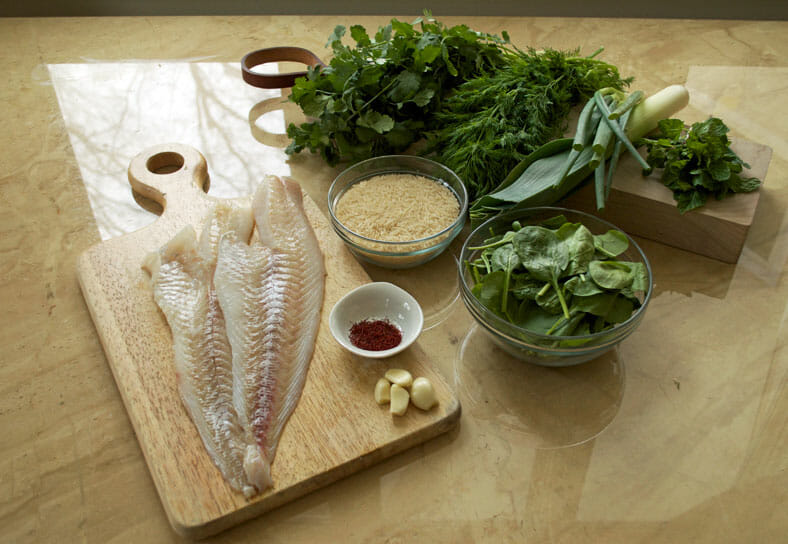
The Art of Polo
It’s important to note here that the Persian word for rice is berenj and not polo. Polo instead is more closely related to the idea of pilaf than raw rice itself. And when it comes to making polo, there is a specific cooking method that is distinctly Persian for making the rice incredibly fluffy and non-sticky.
First, it’s an imperative to pre-soak and clean your rice well ahead of cooking time. The preferred type of rice to use here is basmati rice, but any short grain rice substitute will suffice. The most traditional methods of making polo require that you wash and rinse the rice three separate times to remove as much starch as possible.
Generally, the more time you let the rice soak, the better your chances of generating the perfect level of fluffiness, but at the very least you will need to soak your rice grains for at least one hour in salted water. If you can manage to soak it for even more time than that, even better.
Next, you drain the rice and place it into a pot with boiling water. The goal here is to parboil the rice, meaning you’ll cook it in boiling water for only a few minutes and remove it before it’s fully cooked. If you can, extracting a cup or two of the starchy boiling water before removing the rice is a helpful “pro tip” for the next steaming phase of the rice. Either way, though, for your sabzi polo you’ll want to boil the rice for 8-10 minutes before removing it from the pan and rinsing the rice under cold water to stop the cooking process.
The next step – and perhaps most crucial – in making a good polo is the steaming. For sabzi polo, the rice will be steamed together with fresh herbs, but you can just as easily make other types of polo by steaming the rice with other ingredients. Estanboli polo, for example, is a delicious rice cooked together and steamed with tomato sauce.
The Other Pieces to the Puzzle
There are no clear cut rules as to what types of sabzi, or greens, you need to put into your sabzi polo. Most recipes you’ll find will almost certainly have common herbs like parsley or dill, but you’re very welcome to add any other types of greens and herbs you would like to your own version of sabzi polo.
Aside from the herbs, there are two additional items that can really elevate your sabzi polo to the next level: saffron and tahdig.

When it comes to saffron, Iran is home to some of the finest in the world. Famously known as the most expensive spice in the world, even a tiny dash of saffron can give your sabzi polo an incredibly complex, hard-to-describe yet alluring taste to it. The best way to spread this type of flavor throughout the dish is to grind a few threads in a mortar and pestle, then stirring it through boiling water before dispersing the water-saffron mixture over the polo before it is ready to steam.
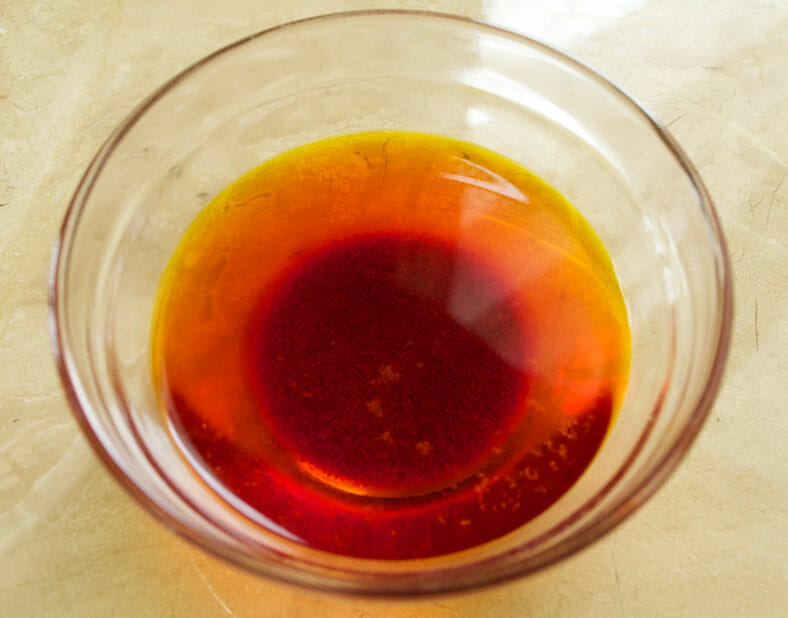
Ah yes, and then there’s the tahdig. A true delicacy in the Persian cuisine, the tahdig is the golden crust of rice that forms on the bottoms and the sides of the pot during the steaming process of the polo. In some cases (as we did with our recipe), you can create a more wholesome version of tahdig by mixing the some parboiled rice with yogurt and use it to create a floor on which to steam the rest of the rice. If you can pull off a truly great tahdig, you’ll understand what makes it so special.
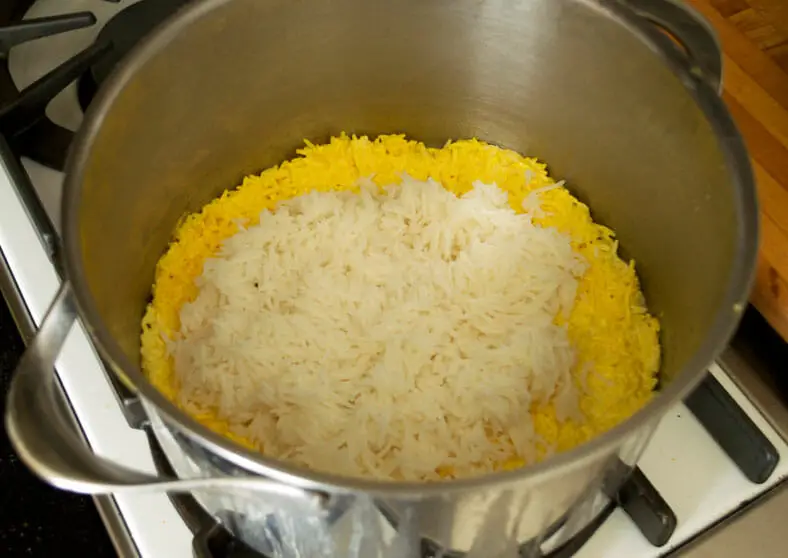
Putting It All Together
Once you have your greens, saffron, potential tahdig mix and parboiled rice ready, the final step to making a truly top-notch sabzi polo is to layer the rice and allow it to steam for a long while.
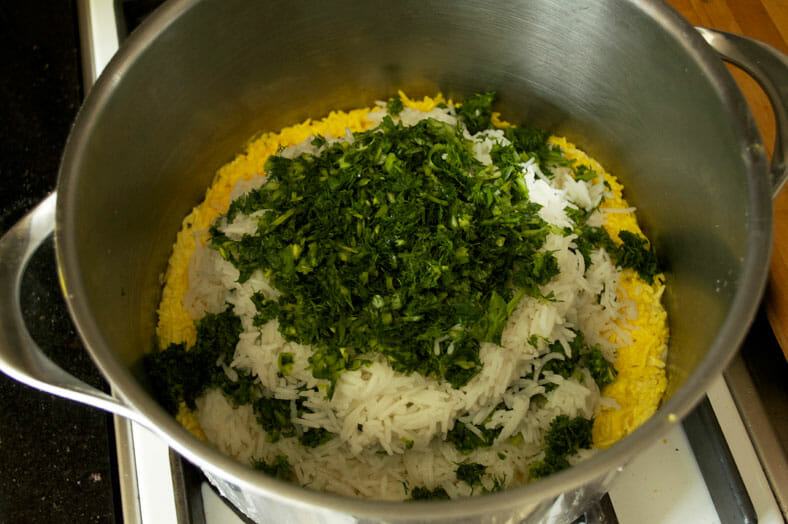
The key to this steaming process is to create a “pyramid” of layers between rice and the herbs until you’ve run out of both ingredients. Then, you’ll want to poke a few holes into the pyramid with the pointy edge of a ladle or spoon (or chopstick), since this combination of pyramid and holes will allow for greater steam circulation during the polo cooking process.

From there, you cover your sabzi polo and let it steam for up to an hour.
In the meantime, you can prepare and cook the mahi filets. Most sabzi polo will either have a smoked fish or fried fish filet accompaniment. Depending on which method you prefer, either you will dryly dredge fish filets into a flour mixture, or you can smoke a fish on a grill. Either method or prep can be done well within the bounds of the steaming process for the sabzi polo.
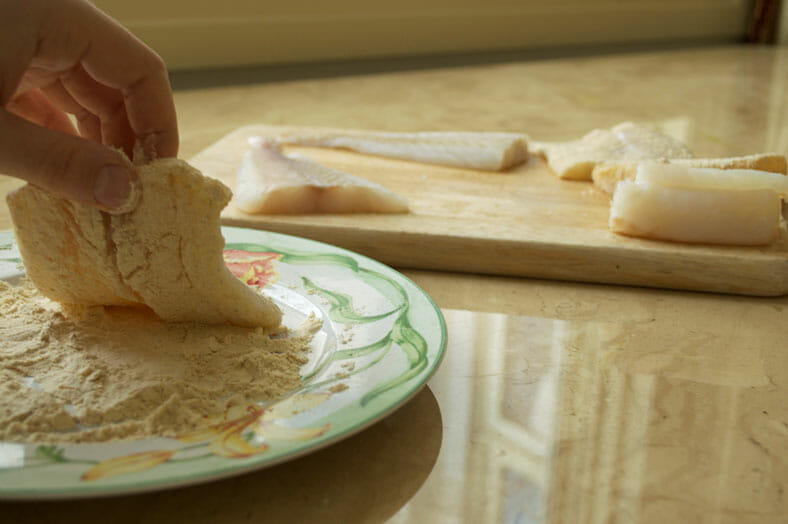
Our Take on the Recipe
For this sabzi polo, we based our recipe off of the original recipe from a cookbook from one of the foremost experts on Persian cuisine, so we felt confident that few adjustments, if any, would be needed to make this recipe truly stellar.
One key area where we deviated was in our inclusion of more herbs. We added a whole slew of additional herbs, as well as garlic and onions, to our sabzi polo. The most notable herb addition was mint, which was a very intriguing strong flavor addition to the dish.
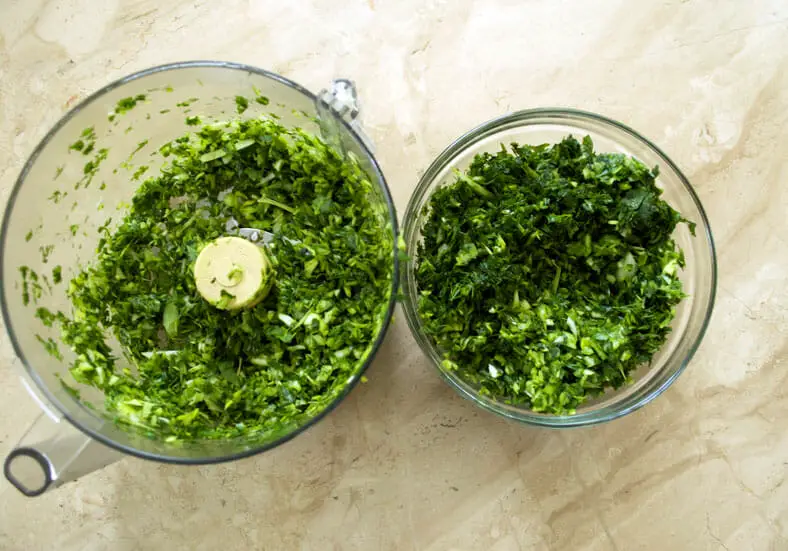
In place of using regular yogurt, we opted for full-fat Greek yogurt for making our tahdig. Compared to the original yogurt, this led to a slightly denser composition of the rice bottom, but the delicious crispy tahdig came out just as great for our sabzi polo.
Finally, for our mahi, we created a slightly healthier breaded version of the fried fish accompaniment. Instead of using all purpose flour and regular oils, we made a breading with a chickpea flour base that was flavored with cinnamon and black pepper. When fried in coconut oil, the fish came out delicious and even had a distinct nutty flavor to it that went really well with the sabzi polo.

Other than that, the recipe (and overall process for making polo) might seem daunting but is actually really easy to handle. And when you do, you’re well on your way to having yourself a perfect Nowruz celebration.
Eid-e-shoma mobarak!
What herbs do you put in your sabzi polo? Comment below!
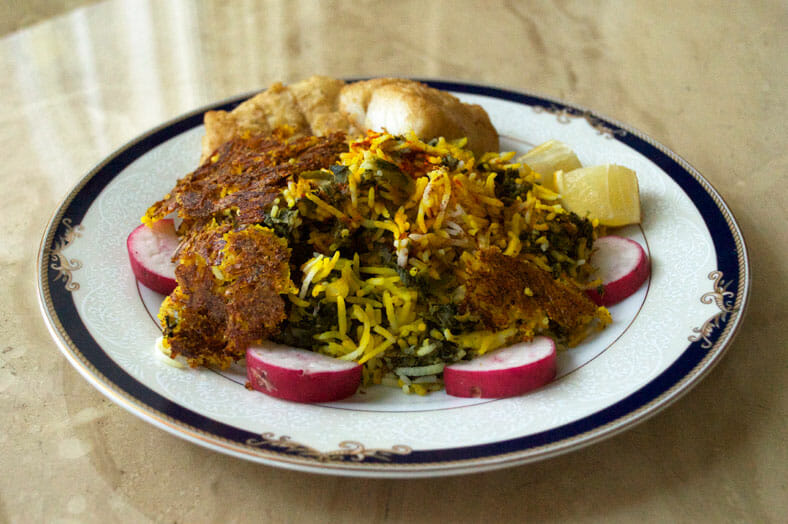

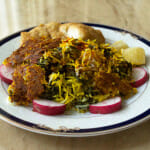
Sabzi Polo ba Mahi
- Total Time: 1 hour 35 minutes
- Yield: 6 people 1x
Description
Sabzi Polo ba Mahi in vegetable broth.
Ingredients
Sabzi Polo
- 1½ cups long-grain basmati rice
- 2½ cups water or vegetable broth
- 1 bunch of spring onions, enough for ½ cup when coarsely chopped
- 1 bunch of fresh dill, enough for ½ cup when coarsely chopped
- 1 bunch of fresh parsley, enough for ½ cup when coarsely chopped
- 1 bunch of fresh coriander, enough for ½ cup when coarsely chopped
- 1 bunch of fresh mint, enough for ¼ cup when coarsely chopped
- 1 whole leek, cut into chunks ready for food processor (on Amazon)
- 1 small onion
- 3 cloves of garlic
- 2 tablespoons butter
- 2 tablespoons Greek yogurt
- 1 teaspoon saffron, ground and dissolved in 2 tablespoons hot water
- 1 teaspoon ground cinnamon
- 1 lime
Mahi
- 1 pound white fish filets (we used cod)
- 3 tablespoons ghee or coconut oil
- ½ cup chickpea flour
- 1 teaspoon ground cinnamon
- 1 teaspoon sea salt
- 1 teaspoon black pepper
Instructions
Stage 1 – Prep Work
- In a bowl, rinse and clean the rice at least 3-4 times under running water. Run your hands through the rice to help clean and until the water becomes less murky
- Once clean, submerge your rice and set aside to let it soak. It’s not mandatory, but very desirable. Even soaking for at least one hour (going up to 8) will make the rice much fluffier
- As the rice soaks, add the spring onions, dill, parsley, coriander, leek, onion, and garlic to a food processor (on Amazon). Pulse greens together until all is finely chopped and combined
Stage 2 – Pre-Cook Rice
- Drain the rice of any water it was soaking in, and add to a stockpot. Submerge in vegetable broth/water and bring to a boil
- Boil the rice in the stockpot over high heat for ~10 minutes until the rice has softened
- Once cooked through, remove the rice from the stockpot and place into a colander. Rinse cold water through the rice. Keep your stockpot for later
Stage 3 – Beginning of Special Tahdig
- In a small bowl, take a ladle-full of cooked rice and mix together with 1 teaspoon of saffron water and Greek yogurt. Mix together until you get a thickened yellowish pudding-like consistency to the rice
- In your stockpot, heat 1 tablespoon of butter until it has melted. Once melted, spread the yellow yogurt rice along the bottom and simmer on low heat for ~3-4 minutes as you prepare the other ingredients
Stage 4 – Making the Pyramid
- Next, you’ll want to create a pyramid of alternating cooked rice and freshly chopped greens in your stockpot. Start with a ladle of cooked rice followed by a ladle full of chopped green stacked on top
- Continue until all rice and greens have been added into the stockpot and have created a layered pyramid in the stockpot. The triangular pyramid shape will help to let the rice expand further as it cooks
- Using a chopstick or something similar, poke small holes into the pyramid. This will allow the rice to steam
- Increase the stockpot to medium heat and cover. Let the rice and greens cook over this medium heat for ~10 minutes
Stage 5 – Final Preparations of Sabzi Polo
- After the initial 10 minutes, uncover your stockpot of rice
- Place another 1 tablespoon of butter at the top of the pyramid of rice
- Drizzle 1 teaspoon of saffron water over the pyramid
- Next, sprinkle the ground cinnamon around all the rice
- Cover and simmer on low heat for another 50 minutes. The absolute best way to do this is to take a dish towel and cover the top of the stockpot (fastened by the lid) to ensure that no steam escapes during the cooking process
Stage 6 – Prepare the Mahi
- In the 10 minutes leading up to the end of the sabzi polo, take a plate and combine your chickpea flour, cinnamon, sea salt and black pepper together. Mix well
- Dredge your fish filets into the flour mixture (do this dry, meaning with no egg wash or anything)
- Heat a skillet over high heat and add your ghee or coconut oil
- Once very hot, add your filets to the pan and fry on each side until golden brown. This should take about ~3 mins per side
- Once golden brown, remove filets from skillet and set aside
Stage 7 – Serving
- To serve, transfer the rice from your stockpot to a serving tray. Try to set aside the yellow rice with saffron water for decorative purposes. Keep the bottom crust of tahdig in the stockpot for now
- Once the rice has been plated, carefully scrape or attempt to remove the tahdig from the bottom of the stockpot, trying to keep as much of it intact and in one piece as possible
- Line your mahi around the rice, and top with the juice of your lime as a final flavor. Enjoy!
- Prep Time: 15 mins
- Cook Time: 1 hour, 20 mins
- Category: Main Dish
- Cuisine: Iranian


Cyrus – I am so glad to have found your blog! We made this last night and it was stupendous. We are still smiling this morning and looking forward to leftovers for lunch! Thank-you.
That’s awesome to hear, Alison! And if anything, the leftovers might actually be better. Many more recipes like this one to come 🙂
Cyrus and Heather, I loved learning about the background of Nowruz, especially how those who celebrate it make changes in their daily lives as part of the celebration. A while back I learned of the concept of tahdig rice (though not its proper name) and since then I’ve dreamt about it. But as with too many things in life, my plans to look up a recipe and make it myself always got waylaid. Now I have no more excuses! And the fish is such a perfect accompaniment.
Thank you, Laura! And yeah, tahdig is a true gem if you have it in its truest form. The fish is great, but it really is all in the tahdig 🙂
Let us know how it goes if this finally stirs you to give it a whirl!
CYRUS! I am the biggest dodo- How did I not know you were Persian?! For some reason, I thought you were Armenian! So thankful I’m stalking your archives!
Haha nope.. Persian and proud of it Arman 🙂